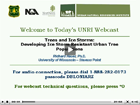Urban Forests – Effects – Energy Conservation
Effects of Urban Forests and their Management on Energy Conservation
UNRI scientists are currently conducting research to determine the influence of trees in urban areas on physical environment–wind, air temperature, humidity, and solar and thermal radiation–and the effects of the environmental changes on health and comfort of people, energy use for heating and cooling buildings, soil and stream temperatures, and outdoor sound propagation. UNRI researchers are working with as principal investigators in the Baltimore Ecosystem Study by directing the collection and analysis of meteorological data related to this long-term scientific study.
The BES reference station is unusual in the large number of variables measured. They include all the variables in LTER Climate Committee Standards for Level 3 Meteorology: air temperature and humidity, precipitation, wind speed and direction, total solar radiation, incoming photosynthetically active radiation (PAR), reflected PAR, atmospheric pressure, soil temperature at two depths, and volumetric soil moisture. Net all-wave radiation and soil heat flux are also measured. The reference station is in a relatively open location in a pasture field. For most variables, both hourly averages and maximum and minimum values are measured.
Please visit the Baltimore Ecosystem Study website for more detailed information on the scope of meteorology research being undertaken in Baltimore, or visit the Syracuse Research Unit for information on other energy conservation research activities.


